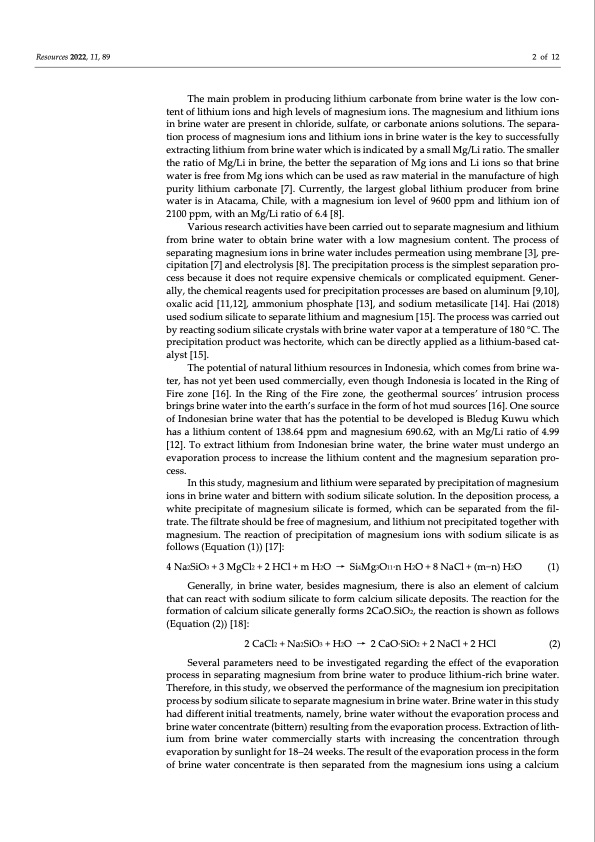
PDF Publication Title:
Text from PDF Page: 002
Resources 2022, 11, 89 2 of 12 The main problem in producing lithium carbonate from brine water is the low con- tent of lithium ions and high levels of magnesium ions. The magnesium and lithium ions in brine water are present in chloride, sulfate, or carbonate anions solutions. The separa- tion process of magnesium ions and lithium ions in brine water is the key to successfully extracting lithium from brine water which is indicated by a small Mg/Li ratio. The smaller the ratio of Mg/Li in brine, the better the separation of Mg ions and Li ions so that brine water is free from Mg ions which can be used as raw material in the manufacture of high purity lithium carbonate [7]. Currently, the largest global lithium producer from brine water is in Atacama, Chile, with a magnesium ion level of 9600 ppm and lithium ion of 2100 ppm, with an Mg/Li ratio of 6.4 [8]. Various research activities have been carried out to separate magnesium and lithium from brine water to obtain brine water with a low magnesium content. The process of separating magnesium ions in brine water includes permeation using membrane [3], pre- cipitation [7] and electrolysis [8]. The precipitation process is the simplest separation pro- cess because it does not require expensive chemicals or complicated equipment. Gener- ally, the chemical reagents used for precipitation processes are based on aluminum [9,10], oxalic acid [11,12], ammonium phosphate [13], and sodium metasilicate [14]. Hai (2018) used sodium silicate to separate lithium and magnesium [15]. The process was carried out by reacting sodium silicate crystals with brine water vapor at a temperature of 180 °C. The precipitation product was hectorite, which can be directly applied as a lithium-based cat- alyst [15]. The potential of natural lithium resources in Indonesia, which comes from brine wa- ter, has not yet been used commercially, even though Indonesia is located in the Ring of Fire zone [16]. In the Ring of the Fire zone, the geothermal sources’ intrusion process brings brine water into the earth’s surface in the form of hot mud sources [16]. One source of Indonesian brine water that has the potential to be developed is Bledug Kuwu which has a lithium content of 138.64 ppm and magnesium 690.62, with an Mg/Li ratio of 4.99 [12]. To extract lithium from Indonesian brine water, the brine water must undergo an evaporation process to increase the lithium content and the magnesium separation pro- cess. In this study, magnesium and lithium were separated by precipitation of magnesium ions in brine water and bittern with sodium silicate solution. In the deposition process, a white precipitate of magnesium silicate is formed, which can be separated from the fil- trate. The filtrate should be free of magnesium, and lithium not precipitated together with magnesium. The reaction of precipitation of magnesium ions with sodium silicate is as follows (Equation (1)) [17]: 4 Na2SiO3 + 3 MgCl2 + 2 HCl + m H2O → Si4Mg3O11·n H2O + 8 NaCl + (m−n) H2O (1) Generally, in brine water, besides magnesium, there is also an element of calcium that can react with sodium silicate to form calcium silicate deposits. The reaction for the formation of calcium silicate generally forms 2CaO.SiO2, the reaction is shown as follows (Equation (2)) [18]: 2CaCl2 +Na2SiO3 +H2O → 2CaO·SiO2 +2NaCl+2HCl (2) Several parameters need to be investigated regarding the effect of the evaporation process in separating magnesium from brine water to produce lithium-rich brine water. Therefore, in this study, we observed the performance of the magnesium ion precipitation process by sodium silicate to separate magnesium in brine water. Brine water in this study had different initial treatments, namely, brine water without the evaporation process and brine water concentrate (bittern) resulting from the evaporation process. Extraction of lith- ium from brine water commercially starts with increasing the concentration through evaporation by sunlight for 18–24 weeks. The result of the evaporation process in the form of brine water concentrate is then separated from the magnesium ions using a calciumPDF Image | Separation of Magnesium and Lithium from Brine Water

PDF Search Title:
Separation of Magnesium and Lithium from Brine WaterOriginal File Name Searched:
resources-11-00089.pdfDIY PDF Search: Google It | Yahoo | Bing
Product and Development Focus for Infinity Turbine
ORC Waste Heat Turbine and ORC System Build Plans: All turbine plans are $10,000 each. This allows you to build a system and then consider licensing for production after you have completed and tested a unit.Redox Flow Battery Technology: With the advent of the new USA tax credits for producing and selling batteries ($35/kW) we are focussing on a simple flow battery using shipping containers as the modular electrolyte storage units with tax credits up to $140,000 per system. Our main focus is on the salt battery. This battery can be used for both thermal and electrical storage applications. We call it the Cogeneration Battery or Cogen Battery. One project is converting salt (brine) based water conditioners to simultaneously produce power. In addition, there are many opportunities to extract Lithium from brine (salt lakes, groundwater, and producer water).Salt water or brine are huge sources for lithium. Most of the worlds lithium is acquired from a brine source. It's even in seawater in a low concentration. Brine is also a byproduct of huge powerplants, which can now use that as an electrolyte and a huge flow battery (which allows storage at the source).We welcome any business and equipment inquiries, as well as licensing our turbines for manufacturing.| CONTACT TEL: 608-238-6001 Email: greg@infinityturbine.com | RSS | AMP |